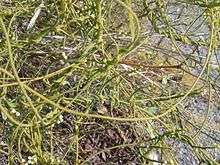Cuscuta reflexa
| Cuscuta reflexa | |
|---|---|
 | |
| Scientific classification | |
| Kingdom: | Plantae |
| (unranked): | Angiosperms |
| (unranked): | Eudicots |
| (unranked): | Asterids |
| Order: | Solanales |
| Family: | Convolvulaceae |
| Genus: | Cuscuta |
| Species: | C. reflexa |
| Binomial name | |
| Cuscuta reflexa Roxb. | |
Cuscuta reflexa, the giant dodder,[1] is one of 100-170 species in the genus Cuscuta.
This plant species is common in the Indian Subcontinent. In Bangladesh it's called as Sworna lotika, Alok lota etc. , Amar bel in India, Aakash beli in Nepal. This parasitic plant species is a leafless twined sprawling thin vine that grows over a host plant. One of the most interesting fact about this plant is it doesn't have roots and stems. The thin vine is yellowish in color, basically that's why it's called Sworna lotika (Golden vine) .This species capable of producing numerous branches which can cover the host plant within a very short period of time and suck life out of the host plant. Flowers are small, bell shaped and white in colour with yellow filaments. Fruits and seeds are produced from the flower. This species is used in producing traditional medicines for the treatment of headache, labour pain, bone fracture, fever, rheumatism etc.[2]
References
- ↑ "Cuscuta reflexa". Natural Resources Conservation Service PLANTS Database. USDA. Retrieved 19 December 2015.
- ↑ "Swarna Lota Ful(স্বর্ণ লতা ফুল) – Cuscuta reflexa". Lonely Traveler. Retrieved 19 December 2015.